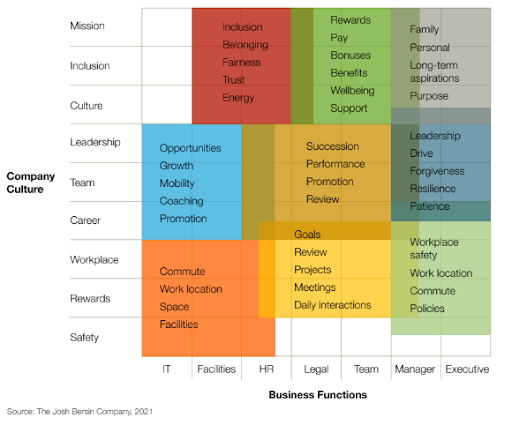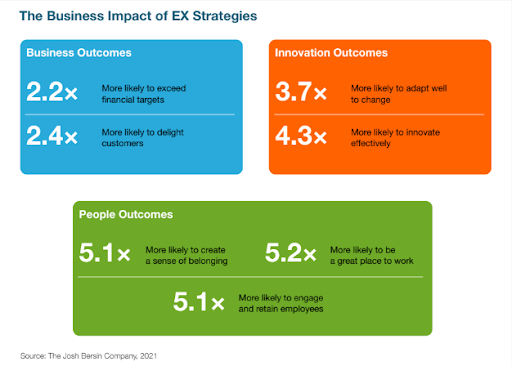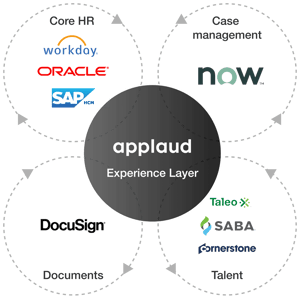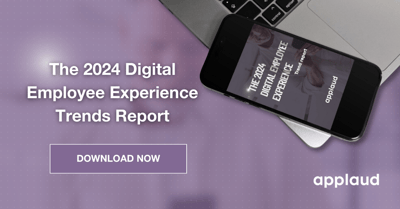Less than a quarter of employees say they are engaged at work. So it’s understandable that businesses have tended to prioritize employee engagement.
But what if employee engagement is simply a symptom of the health of the overarching employee experience?
Employee experience is nothing new. It’s just that now we recognise the central role it plays. To attract and retain top-notch talent, HR teams and companies need to do more than simply engage employees. They need to offer and deliver the full package that their potential employees are looking for.
Digital tools such as employee experience platforms (EXPs) allow HR teams to create and shape an attractive all-round employee experience. But how do you know if you need an EXP? Can’t you just use your usual HR tools? And if you do want an EXP, how do you choose the right one?
In this guide, we will look at:
- Why employee experience management matters
- Whether you need an EXP
- The business case of employee experience platforms
- A checklist of what to look for when selecting an EXP
 Your Guide To: Employee Experience Platforms (EXP)
Your Guide To: Employee Experience Platforms (EXP)
Read Josh Bersin's report to learn more about the EXP market and it's future, what to look for in an EXP and how companies are using them to transform their employee experience. Read Now.
Why does employee experience matter?
Employee experience is the whole deal – the way employees feel about all aspects of their working environment:
- The tools they use to do their jobs.
- The opportunities for career development and progression.
- The company culture.
- How they engage with their colleagues and managers.
HR expert Josh Bersin explains that the employee experience comprises “the work we do, for sure. But it's also about the teams we work on; our direct managers and how they coach and support us; our health and wellbeing; the digital, physical, and cultural workplace; how we grow and develop; and how much we trust the organization.”

The employee as customer
As employees have become more actively selective in their careers, they are becoming customers choosing between employment options. By extension, employers are effectively marketing themselves as products to their potential employees.
HR departments need to be mindful of what employees are looking for, just as marketing teams need to be mindful of what consumers are looking for. That means taking into account the working culture, the technology, and the workspaces, both physical and virtual. The more appealing your offer, the more successful you will be in attracting and retaining talent.
The employee experience is your company’s unique selling point. But how do you make sure you have a truly compelling USP?
The answer may be digital.
Why technology is key to the employee experience
Today’s employees expect to be able to self-serve the HR information and services they need. After all, they’re used to helping themselves using digital technology: they’re banking online, paying bills online, buying flights online.
However, conventional HR tools were designed with HR teams in mind – not employees. The resulting monolithic platforms excel at administrative efficiency. Unfortunately, they often lack the flexibility and ease of use to meet the needs of employees.
To create an employee experience that will meet the expectations of today’s more demanding workforce, HR services must become more agile. They need more user-friendly HR tools that enable employees to manage their own experience easily.
Do you need an Employee Experience Platform?
Some companies are trying to solve the problem of offering better digital support to employees by buying in technology to address specific issues. For instance, they might replace an existing HR-focused learning management system (LMS) with a more employee-friendly learner experience platform (LXP).
The problem with this is that it benefits the employees at the expense of a centralized system – two steps forward and one step back. Adding more tools creates more complexity for HR teams and more new technology for employees to learn.
The solution is an Employee Experience Platform. These tools unite the HR tech stack, so there’s no need to start from scratch or add multiple new tools to your existing platform. Platforms like Applaud can integrate with your existing systems, allowing both HR teams to evolve, innovate and react seamlessly and without disruption. By just adding this experience layer, you can reframe your HR tech to focus on the employee and put the ‘human’ back into human resources.
The Business Case for EXPs
The business impact of EX strategies is compelling. Just consider the following outcomes from a 2021 study by the Josh Bersin Company. Businesses that focus on the employee experience are:
- More than twice as likely to exceed financial targets.
- 5 times more likely to engage and retain employees.
- 4 times more likely to innovate effectively.

But how about employee experience platforms? Can they help – and if so, how?
Here are the 4 main ways in which an Employee Experience Platform can benefit employees and HR teams alike — and in doing so, benefit the business as a whole.
1. EXPs can deliver a personalized consumer-grade experience
It’s the little details that make the real difference to the employee experience:
- Using people’s preferred names.
- Acknowledging and celebrating personal milestones.
- Reflecting their individual interests in content suggestions.
Many EXPs, such as Applaud, are incorporating the sort of hyper-personalisation that we are coming to expect from the consumer experience. And when employees feel better about their working experience, they are more likely to perform better and want to stay on board.
2. EXPs support a seamless employee journey
Technology solutions make life easier both for employees and for HR teams. An EXP gives employees access to a consumer-grade experience at all stages of their employee journey, from onboarding to offboarding and everything in between:
- Easier onboarding
An EXP makes it easier for new hires and new joiners to find what they need to learn and do their tasks.
- More accessible HR services
It gives employees a self-service solution to their day-to-day HR issues — whether that’s logging time, resolving payroll queries, booking holidays, viewing benefits or accessing learning and development options.
- More HR time on strategic priorities
Just as importantly, this frees up HR and people management teams from those basic, repetitive and time-consuming admin tasks and queries, so they can focus on more substantial issues.
3. EXPs can be continually improved
Delivering a great employee experience in the digital age is an ongoing process. It’s no longer enough to simply rely on quarterly or annual updates, and expect that to keep everything running smoothly.
As consumers, we’re well used to our apps and operating systems being regularly adapted, updated and versioned in response to need and to consumer feedback. Similarly, employee experience tools can be updated at point and time of need, based on continuous, real-time user feedback. In this way the EXP — and the employee experience itself — evolves to meet employee and organizational needs .
4. EXPs can be customized to match your brand
EXPs can provide customisable options that give companies the options to configure systems to match with their existing infrastructure. An EXP can allow companies to overlay their brand and feel, and to customize the platform to their unique best needs. This helps create a consistent experience for employees that is still reflective of and relevant to the organizational brand.
Choosing the right widgets and layout for your people, and optimizing for the devices your employees use, means you can create a unique platform that will be engaging and easy to use. Similarly, platforms like Applaud let you design user interfaces that look and feel like the sort of digital products employees use in other areas of their lives. This makes for a more appealing and intuitive experience for employees.
For more insight take a look at the below video, where Josh Bersin and Applaud's Duncan Casemore discuss Employee Experience Platforms.
Checklist: What to look for when choosing an EXP
If you’re in the market for an EXP, you might be wondering what features to look out for.
Here are a few key functions that you always should check for:
☑ Is it accessible from anywhere?
Mobile access points have become almost second-nature for both personal and consumer use. We bank by mobile, we pay by mobile, we book flights and concert tickets by mobile, and then use our mobiles as our tickets.
Your employee experience apps must offer that consumer-grade mobile experience. That way, the employee experience becomes more intuitive and familiar for people to navigate.
☑ Does it integrate easily with your other HR tools?
 You don’t want to force employees to work with multiple HR apps–that’s the exact opposite of the seamless experience we’re going for here!
You don’t want to force employees to work with multiple HR apps–that’s the exact opposite of the seamless experience we’re going for here!
For instance, Applaud integrates with most other HR or learning providers like Workday or Cornerstone - users can directly engage with these without having to leave the Applaud employee portal. This means that, rather than fragmenting things with numerous apps, users have one seamless employee experience app that they can consistently interact with. Everything - from tracking pay and benefits to updating and requesting time off, or exploring learning and wellbeing resources – is available through a single employee portal.
☑ Can you integrate performance management too?
Having an EXP eliminates the need for separate performance management systems. All the functionality for goal-setting, reviews, regular check-ins can be handled in the one system, integrating the data into the existing HR systems.
What’s more, by automating the data and analysis, HR teams and managers are better able to focus on the human side of performance conversations. The digital employee experience is not run by digital technology alone. It comes from creating the space to focus on the moments that matter, such as recognising and sharing successes or handling performance issues with the sensitivity and personal touch they need.
☑ Will it help create a solid knowledge management system?
With a consumer-grade EXP, HR teams can deliver the content, the knowledge, the actions and tasks to employees at those crucial points in their employee journey. Applaud’s knowledge base allows HR teams to sync the company’s existing knowledge sources, and to create their own relevant content, directly on the platform. With rich content like videos, links and rich text, HR teams can offer employees the sort of engaging, multifaceted material they are used to.
By offering employees the opportunity to rate and comment on content, or suggest new topics, you can keep them involved and engaged, while also ensuring content is fresh and relevant.
Not only that, but the technology understands their role and their persona to know what content, policies or material that they will need at the right time.
Don’t your employees deserve a better experience?
In a very mobile and volatile world, it’s vital for organizations to evolve. Today’s workforces have different expectations and needs when it comes to their employee experience. With the distinctions between life and work more blurred than ever, employees want an employee experience that mirrors their customer experience. Finding the right consumer-grade platform that is agile and accessible is absolutely critical to engaging and motivating those employees.
Applaud provides a workforce experience platform that makes digital HR simple, supporting and enhancing your existing HR services, rather than replacing them. Instead, EXPs build applications for the various use cases on top of a company’s legacy infrastructure.
To see how Applaud can help your HR teams deliver a great customer experience, schedule a consultation.
Want the big picture on Digital Employee Experience?
Get the tools and industry insights to embrace generative AI's transformative power with confidence, helping you craft a strong business case for adoption. Download the 2024 Digital Employee Experience Trends Report today.



